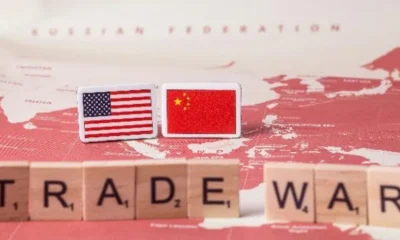Markets
Rupee’s Falling Spree, All Time Low Of 85.87/$ And Could Fall Further. Low GDP Forecasts, FPI’s Pulling Out And Trump’s Policies, What’s The Outlook?
Published
9 months agoon

2024 wasn’t kind to the Indian rupee, which ended the year on a sour note, hitting an all-time low of 85.65 against the US dollar on December 27. With media buzzing about the potential fallout of a weaker rupee, it’s time to dissect what this really means for the economy and whether it helps exports as much as some believe.
On Wednesday, the Indian rupee continued its relentless downward journey, hitting a new record low of 85.87 against the US dollar, slipping 13 paise in a single session. This marks the second straight day of decline, driven by rising crude oil prices, a stronger US dollar, and a host of domestic and global factors.
What’s Driving the Fall?
A surge in global crude oil prices has upped India’s import bill, putting pressure on the rupee. Meanwhile, the US dollar continues to strengthen, buoyed by rising bond yields and positive economic data from the US.
Likewise, Foreign portfolio investors (FPIs) have been pulling money out of Indian markets, spooked by slowing economic growth and better opportunities in other economies.
Adding to these woes, subdued performance in Indian equity markets has further dampened investor sentiment. On Wednesday, the Sensex was down 180 points, and the Nifty shed 47 points, reflecting the nervous mood.
The Indian government’s recent GDP forecast downgrade for FY25 to 6.4%—a four-year low—has only added fuel to the fire. Weakness in manufacturing and services has been a major drag.
The rupee’s decline picked up pace during the US election campaign and intensified after Donald Trump’s victory in November. His administration’s expected stringent monetary policies have strengthened the dollar, further pressuring emerging market currencies like the rupee.
By the Numbers
—The rupee opened at 85.82 on Wednesday and touched an intra-day low of 85.89 before settling at 85.87.
—On Tuesday, it closed at 85.74, marking a 6-paise drop.
—The dollar index, which measures the greenback’s strength against six major currencies, rose 0.35% to 108.76.
—FPIs sold off a net Rs 1,491.46 crore in Indian markets on Tuesday.
Broader Concerns
The weakening rupee reflects broader economic challenges. India’s GDP growth slowing to 6.4%—the lowest since the pandemic year—illuminates vulnerabilities in key sectors like manufacturing and services. With crude oil prices rallying and capital flows easing, the rupee faces additional downward pressure.
Market experts predict more pain ahead for the rupee, with its trading range hovering between 85.68 and 85.89 for now. A combination of weak domestic fundamentals, global uncertainties, and aggressive US monetary policies makes a swift recovery unlikely.

Can the Government Do Anything?
While the Reserve Bank of India may step in to stabilize the rupee through forex interventions, the scope for action is limited without broader economic reforms. Measures to attract foreign investments, improve manufacturing output, and support growth could help, but these are long-term fixes.
For now, businesses and investors need to brace for a turbulent ride as the rupee struggles with both domestic and global headwinds.
What Does a Weak Rupee Mean for the Economy?
On the surface, a depreciating rupee translates to higher import costs, especially for crude oil, which forms a significant chunk of India’s import bill. This not only widens the current account deficit (CAD) but also pushes up inflation domestically.
India’s overall trade deficit jumped to 3.4% of GDP in Q2 FY25, up from 2.9% a year earlier. The merchandise trade deficit climbed to 8.2% of GDP from 7.5%.
A larger CAD often leads to declining foreign exchange reserves and erodes investor confidence, prompting foreign institutional investors (FIIs) to pull out of the stock market.
Does a Weaker Rupee Help Exports?
The textbook answer is “yes,” but India’s reality is more nuanced. While a cheaper rupee might boost price-sensitive exports like textiles or footwear, the composition of India’s export basket has shifted significantly over the years. Items like refined petroleum products, engineering goods, and chemicals—key contributors to India’s export earnings—are more influenced by global income levels than currency depreciation.
Between 2000 and 2014, the rupee’s depreciation did help improve the trade balance. However, as income-sensitive goods took over, this relationship weakened.
India has transitioned into a major player in several high-value export segments:
- Refined Petroleum Products: 21% of the export basket, valued at $85 billion (12.6% global market share).
- Engineering Goods: Includes machinery and transport equipment.
- Other Key Exports: Insecticides (10.5%), steel (12.7%), and gemstones (36% global market share).
Global Challenges Dampening Export Potential
A weaker rupee alone can’t fix the export puzzle, especially when global demand is tepid.
Weak economic growth in key markets like the Eurozone and China has dented demand for income-sensitive goods. China’s GDP growth is expected to dip below 5% in 2025, while the Eurozone grapples with stagnation.
The US, a critical trading partner, is contending with higher-than-average inflation at 3%. Add Trump’s tariff policies to the mix, and India’s exports face another roadblock.
Why the Rupee’s Decline May Persist—and Why It’s Not All Bad
The rupee’s continued fall against the dollar has raised eyebrows, but understanding the factors at play can help put the situation into perspective. The exchange rate is influenced by two primary factors:
Goods Market Approach: This is based on the ‘law of one price’ (LOOP) and purchasing power parity (PPP). If domestic inflation outpaces US inflation, the rupee depreciates. Historically, India’s higher inflation compared to the US reflects a productivity gap. For instance, in 2025, India’s output per worker is estimated at $25,431—far below the US average of $153,446, according to ILO data.
Asset Market Approach: This depends on capital flows. With renewed confidence in the US economy, driven by Trump’s promises of economic revitalization, fund managers are moving capital out of India. Foreign investors sold Indian equities worth ₹113,858 crore in October and ₹41,872 crore in November 2024, further pressuring the rupee.
While the annual depreciation of the rupee remains within a manageable range (below 4%), persistent pressures suggest this trend is likely to continue.
Despite government initiatives like Make in India and Atmanirbhar Bharat, the structural challenges in India’s trade dynamics persist. Crude oil, precious metals, and coal dominate imports, contributing to a rising current account deficit (CAD). Efforts to make exports more competitive have yet to deliver the desired impact.
Silver Lining?
However, there may be some positives to the falling rupee; a weaker rupee makes India an attractive destination for businesses, as the cost of labor, land, and capital becomes more competitive. The rise of Global Capability Centres (GCCs) in India is evidence of this. With 1,700 GCCs already established, the market is projected to grow to $100 billion by 2030, employing 2.5–2.8 million Indians.
Secondly, India leads the world in remittance inflows, receiving $111 billion in 2022—more than double its foreign direct investment (FDI) inflows. A weaker rupee further amplifies the value of these remittances.
Third, the rupee’s depreciation enhances the competitiveness of India’s IT services exports. Software exports remain a bright spot, helping to offset the trade deficit in categories like mineral fuels and oils.
Unlike many South Asian economies, India’s diverse economic base provides a cushion against the adverse effects of a weakening currency. While countries like Pakistan and Sri Lanka struggle with severe growth challenges due to currency depreciation, India’s software exports, remittances, and GCC-led growth offer a more balanced outlook.
The Last Bit
A falling rupee is not inherently disastrous, but it does point to the need for structural reforms. Improving labor productivity, reducing reliance on imports like crude oil, and strengthening export competitiveness are critical for long-term economic stability. At the same time, leveraging the advantages of a weaker rupee—such as attracting investments and boosting service exports—can mitigate its downsides.
Hence, will and can India capitalize on these opportunities or let structural inefficiencies dictate its economic trajectory?
You may like
-


Taiwan’s ‘Historic’ TSMC Deal, A Win Or The End Of Its ‘Silicon Shield’ As China Threatens? A Jittery Taiwan Watches Trump’s Moves On Ukraine, Wondering, Could We Be Next?
-


A Trade War That Just Won’t Quit. As Trump’s Tariffs Hit, China Stays The Course, For Xi’s Its Business As Usual Strategy
-


Indian Stock Market In Turmoil. Investors In Panic Mode, Is This A Temporary Correction Or The Start Of A Bear Market?
-


America And China’s Thirst For Gold In 2025 Is Draining Other Countries’ Reserves; Here’s Why?
-


Shakeup In The Auto Sector. Mercedes-Benz 15% Job Cuts, Nissan CEO Exit, And Germany’s Make-Or-Break Year
-


DeepSeek Ai Rush. China’s AI Contender Gears Up for Next Big Launch Even As It Gets Xi Jinping’s Blessings

